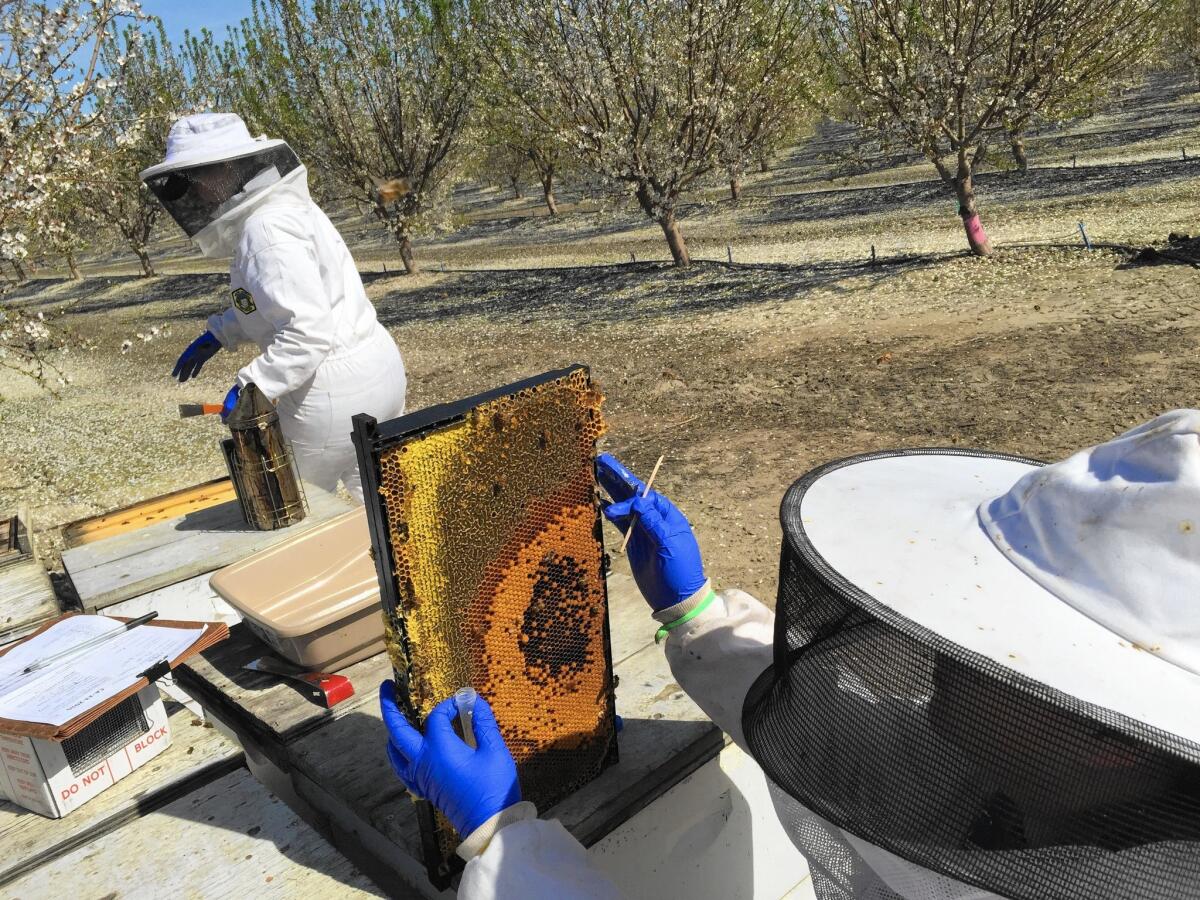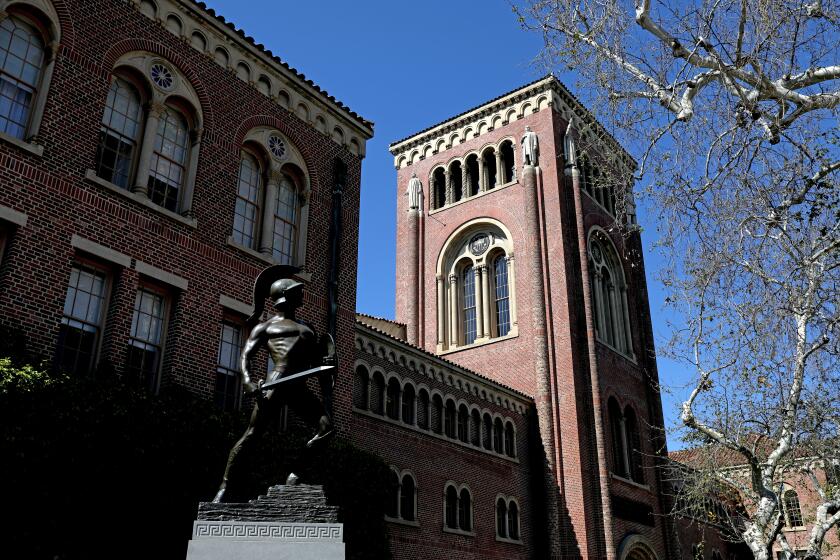How the honey bee crisis is affecting California’s almond growers

- Share via
reporting from SHAFTER — The last of the evening light had disappeared, stealing the incandescence from a million pink and white almond blossoms. Inside the modest conference room of a research facility once operated by the U.S. Department of Agriculture, the South Valley Bee Club convened its regular meeting.
More people than usual — 51 — turned up Tuesday. A sprinkling were out-of-staters, part of a huge migration of keepers and their bees who trek to California each year from as far as Florida and New Jersey for what has been called the planet’s largest “managed pollination” event.
Without bees, there can be no almonds. In fact, each of California’s nearly 1 million acres of almond orchards requires two hives. But California beekeepers have only a quarter of the needed hives.
As almond acreage has exploded and bees have been in some kind of crazy death spiral, growers have been in a mild state of panic over where to find enough little pollinators.
As a result, they are willing to pay dearly — up to $180 to rent one hive for a couple of weeks.
“None of us wants to get into the bee business,” said Los Banos almond grower Joe Del Bosque, whose bee budget is $250,000 this year. “Bees are livestock. It’s like owning a dairy. A lot of work.”
Hence, the annual bee migration.
“We’re the whores of agriculture,” said Dave Hackenberg, a Pennsylvania beekeeper, who rents his hives on a national circuit, starting with almonds in February, ending with Brazilian peppers in Florida in the winter.
::
After the bee people finished their barbecue dinner, they turned their attention to two of the world’s leading bee researchers.
David De Jong has studied bees in Brazil for more than 35 years, and is an expert on a particular mite that plagues bee colonies. Jeff Pettis of the USDA’s Bee Laboratory in Beltsville, Md., has been instrumental in determining why bee colonies are in such steep decline.
Bottom line: There’s no single cause for the weakening or untimely demise of the tiny creatures that make the almond harvest possible. The idea of a mysterious “colony collapse disorder” has seized the public imagination — who among us does not love bees, or at least the idea of bees? — but it’s mostly a misnomer.
Bee failure has multiple, probably interlocking causes, many of which are still poorly understood. Bees are vulnerable to pesticides and pests such as the varroa mite, fungicides and fungus, and a host of viruses that cause them to fly slowly, or act demented or die prematurely.
Pettis has looked at the effect of high and low temperature spikes on queens during transportation, and drone sperm motility issues.
What else hurts bees? “Cellphones,” joked one beekeeper. “Aliens,” said another.
Finally, Jack Brumley, a Porterville-area beekeeper with 40 years of experience, could take it no longer.
“We’ve been talking about this problem for what, 10 years?” said Brumley, 72, who told me he lost more than half of his 9,000 hives this year. “How many more academic papers do we have to pay for? How many more PhDs do we have to educate before we get some information that I can take home and use?”
Knowing laughter rippled through the room.
“Don’t bark at me,” Pettis said. “You need to talk to some of the people down in Washington, D.C., and get a few more of us out in the field that care about the industry.”
In 2014, President Obama, acknowledging the critical state of bee colony health, ordered the creation of a national strategy “to promote the health of honey bees and other pollinators.” The goal is to reduce honey bee colony losses to no more than 15% within a decade.
Needless to say, people in this room aren’t holding their breath.
::
On Wednesday morning, on the edge of a fragrant almond orchard south of Bakersfield, I donned a rather fetching white bee suit and joined two University of Maryland entomology students collecting bees for testing by the USDA’s Animal and Plant Health Inspection Service.
Kneeling on the ground, Nathalie Steinhauer, a doctoral student, stuffed pine needles into a baffled smoker, lit them, then gently puffed smoke into square wooden hives to calm the bees, which, to put it mildly, can get agitated when disturbed.
I had learned this the hard way a few days earlier, when I visited one of Del Bosque’s orchards in Firebaugh, north of Fresno, with his longtime beekeeper, Rosemary Grissom. As I approached a hive to shoot some photos, Grissom ordered me to back away from it quickly but calmly.
I was wearing black, a color that displeases bees because it makes them think bears, their natural enemies, are coming for their honey. I didn’t move quite fast enough.
Let’s just say I now have a visceral understanding of what it means to have a “bee in your bonnet.” There is no mistaking the sound of an angry bee, especially when it’s stuck in your hair.
Steinhauer’s colleague, Meghan McConnell, a master’s student, gently pried frames from their hives. Each frame was covered in thousands of cells, filled with honey, or pollen, or larvae or pupae. Being careful to avoid hurting the queen bee, who is essential, McConnell shook each frame into a pan, then scooped up a quarter-cup of bees into a live-bee box or a jar of alcohol.
Back in the lab, the live bees will be tested for viruses; the dead ones for pests. With a narrow stick, she painstakingly collected pollen to test for pesticides.
“Look here,” McConnell said. “You can see two babies being born.”
In a corner of the frame’s spectacular swirl of brown, orange and yellow, two new bees poked their teensy heads out of hexagonal cells.
In a day, they’ll be at work in the almond blossoms. In a few weeks or so, they’ll be dead. In a perfect world, the hive would live on, ad infinitum. These days, survival is always in doubt.
Anyway, next time you pop a handful of almonds, thank a bee.
Twitter: @AbcarianLAT
More to Read
Sign up for Essential California
The most important California stories and recommendations in your inbox every morning.
You may occasionally receive promotional content from the Los Angeles Times.











